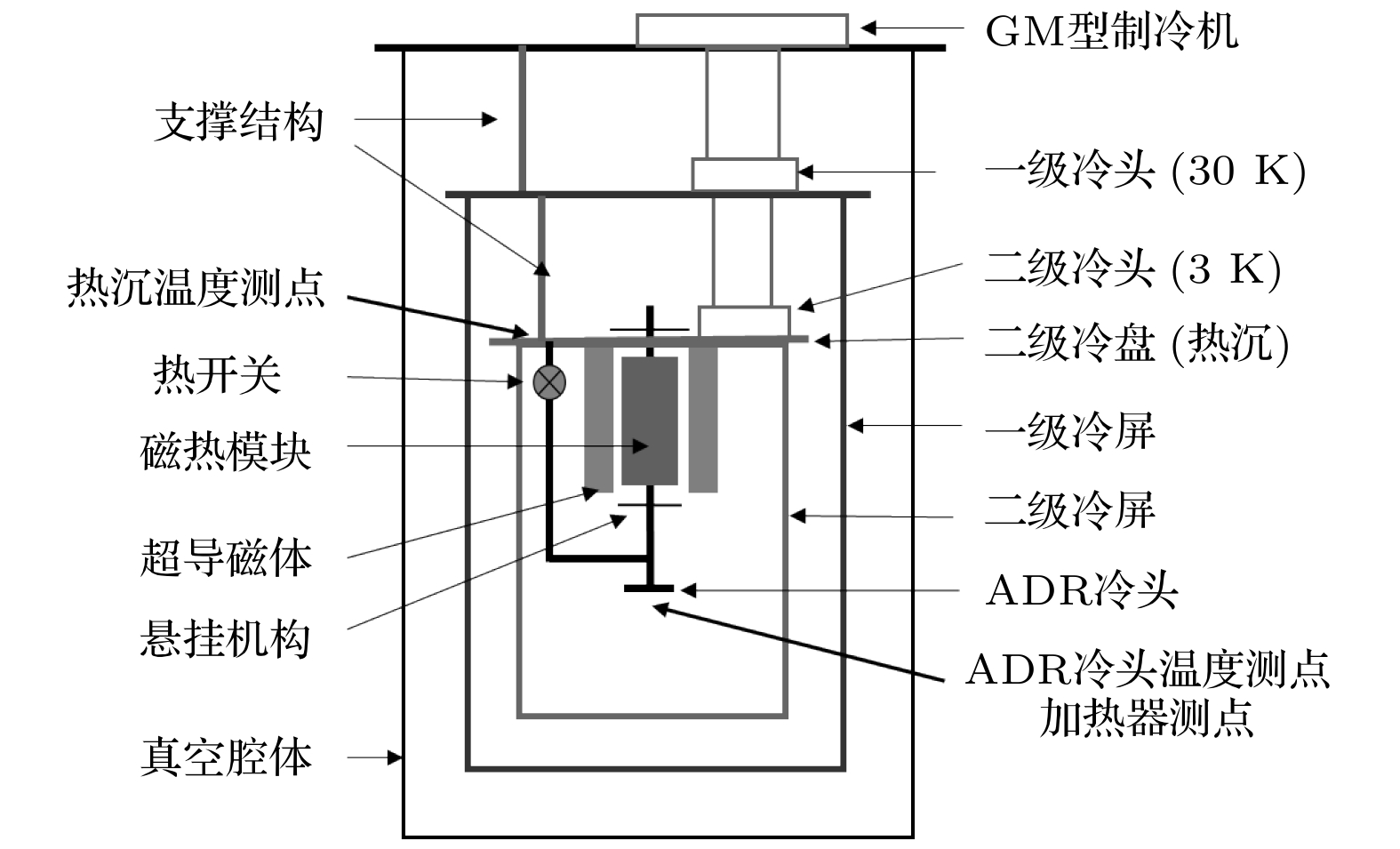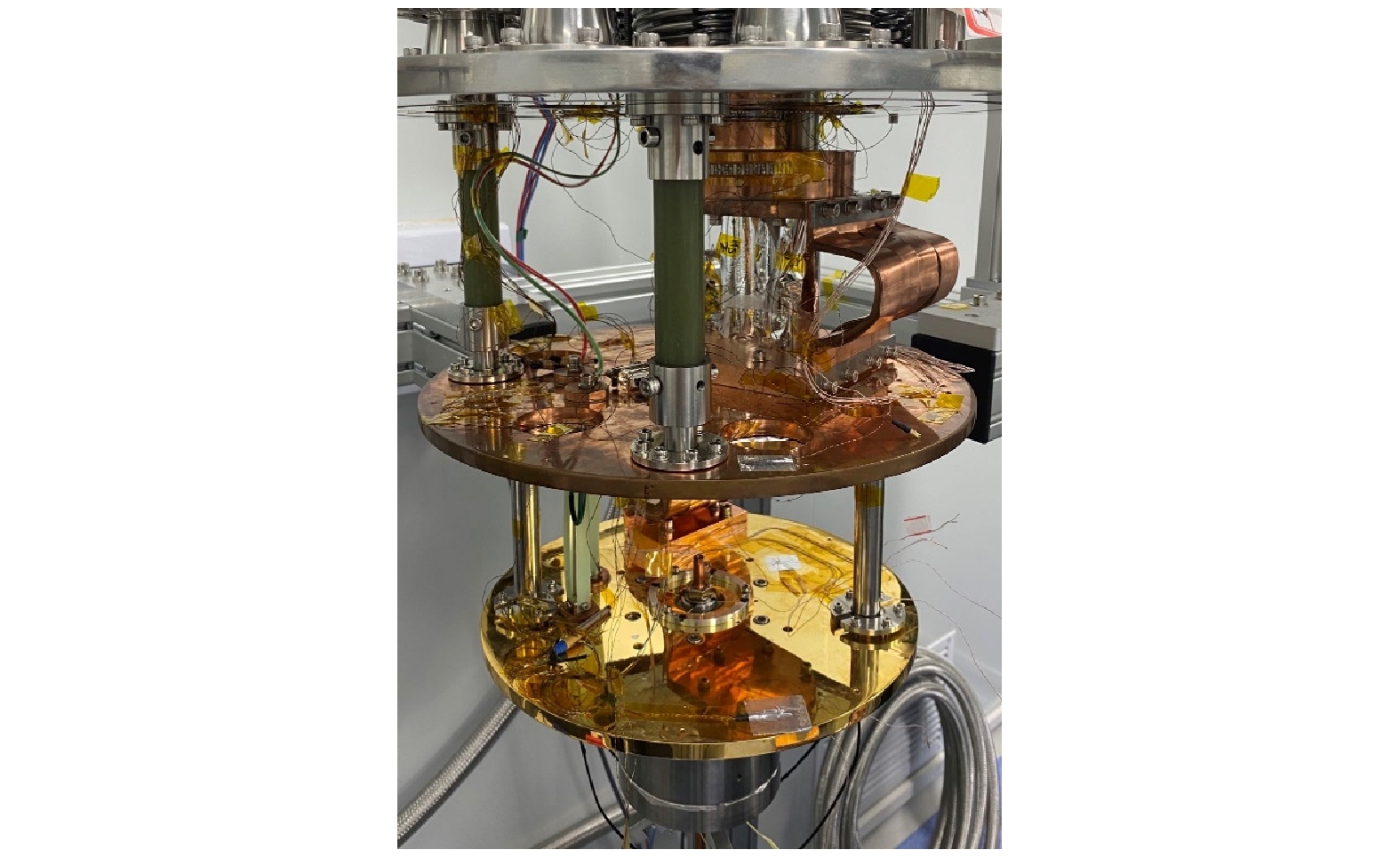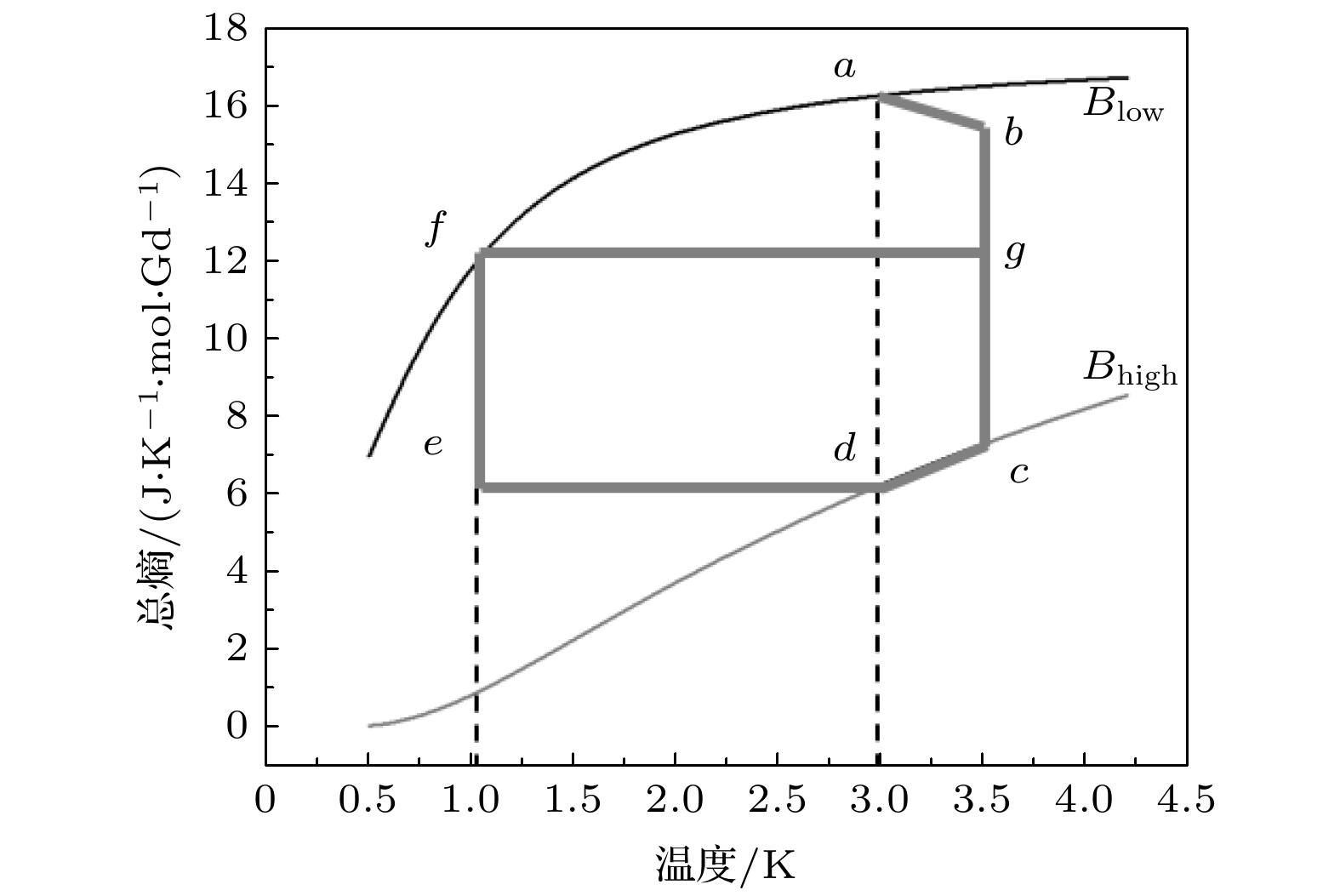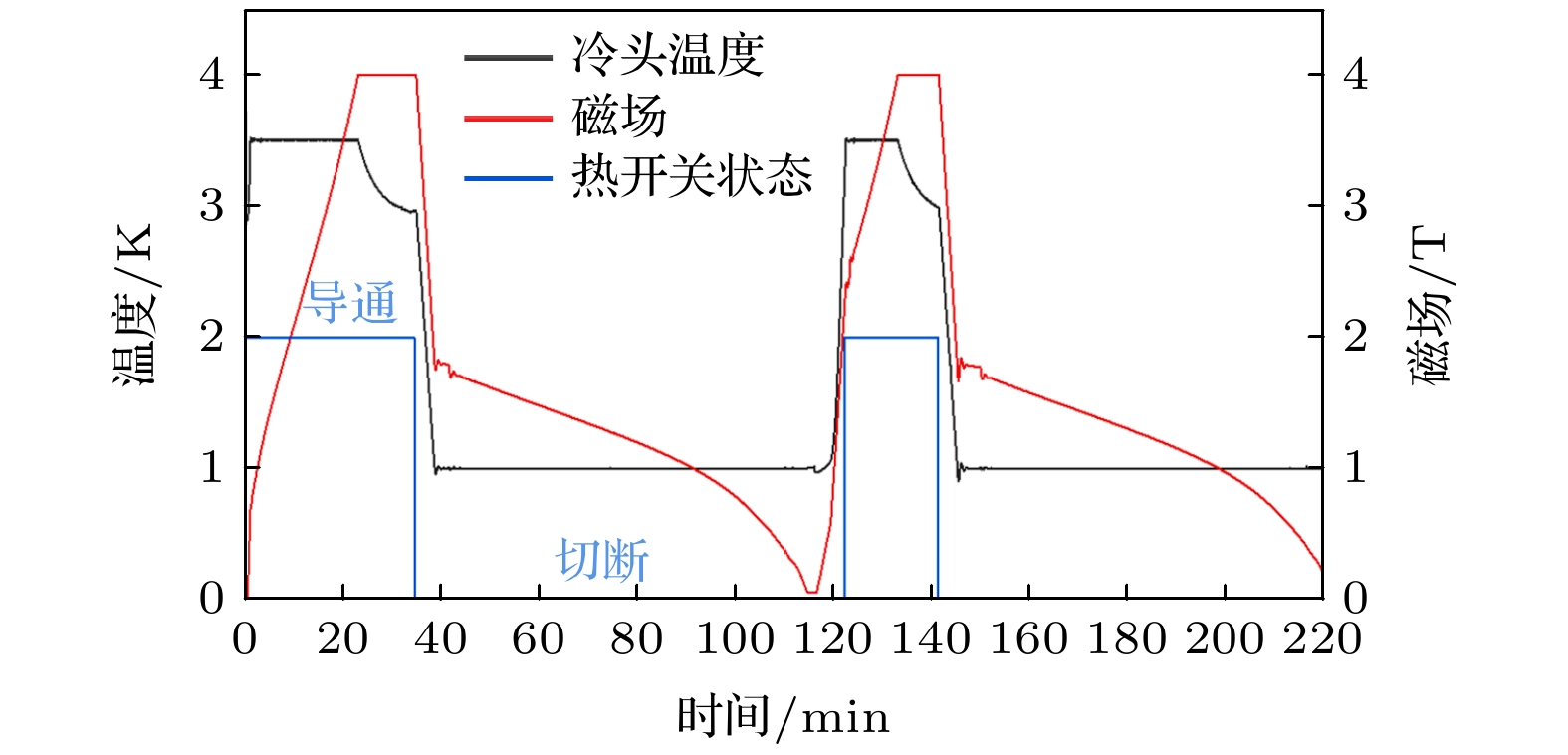-
随着空间观测、量子技术等前沿科研领域的发展, 亚开温区的极低温制冷需求日益增加. 本文设计并研制了一台极低温单级绝热去磁制冷机. 该制冷机由GM型制冷机提供约3 K热沉, 以钆镓石榴石为磁热工质, 由超导线圈提供最大为4 T的磁场, 通过绝热去磁, 实验最低温度可达470 mK. 在恒温控制模式下, 可在1 K下提供2.7 J冷量, 温度波动小于0.5 mK, 绝热去磁制冷的第二热力学效率为57%; 在0.8 K下, 制冷量为1.2 J. 该制冷机将作为50 mK温区三级绝热去磁制冷系统中的第一级, 在1 K下提供0.7 mW制冷功率. 本研究为进一步开展极低温多级连续绝热去磁制冷奠定了基础.
With the development of space observation, quantum technology and other frontier scientific research fields, the demand for ultra-low temperature refrigeration in sub-Kelvin region is increasing. Compared with dilution refrigeration and sorption refrigeration, adiabatic demagnetization refrigeration (ADR) has the outstanding advantages of high efficiency, compact, gravity independence and accessibility of working materials, which make ADR a promising technology for sub-Kelvin cooling. A single-stage ultro-low temperature adiabatic demagnetization refrigerator is designed and developed. The thermodynamic principle and quantitative analysis are presented, from the macroscopic and microcosmic view, and operating results show good agreement with the theoretical value. This refrigerator is precooled to 3 K by a GM-type refrigerator, with 252 g gadolinium gallium garnet (monocrystalline) used as a working medium. The maximum magnetic field of 4 T is provided by a superconducting coil. Flexible heat connection is used between the pre-cooler and ADR, so heat generated by vibration decreases. From (3 K, 4 T), the lowest temperature can reach 0.47 K by adiabatic demagnetization, which is consistent with the result drawn from the entropy data. In a constant-temperature-control mode, the demagnetization rate is controlled by a feedback loop, so the temperature can be held in the presence of a load. A cooling capacity of 2.7 J is provided at 1 K, with temperature fluctuation being lower than 0.5 mK, and the second thermodynamic efficiency of adiabatic demagnetization refrigeration is 57%. at 0.8 K, the cooling capacity is 1.2 J. Future work on improving the performance includes the improving of the on-off ratio of the heat switch, so, the irreversible loss caused by the heat transfer temperature difference in conduction state can be reduced. Improving the heat transfer performance of the salt pill, the heat can be ejected in a shorter period. This refrigerating machine is the first Chinese adiabatic demagnetization refrigeration system that can be operated in circulation, which is expected to be the 1st stage of a three-stage adiabatic demagnetization refrigeration system in a 50 mK temperature zone. This study lays a foundation for further developing continuous multistage adiabatic demagnetization refrigeration at ultra-low temperature. [1] Collaudin B, Rando N 2000 Cryogenics 40 797
 Google Scholar
Google Scholar
[2] Coccia E 2000 Physica B 280 525
 Google Scholar
Google Scholar
[3] Osheroff D D, Richardson R C, Lee D M 1972 Phys. Rev. Lett. 29 88
 Google Scholar
Google Scholar
[4] Hornibrook J M, Colless J I, Lamb I D C, et al. 2014 Phys. Rev. Appl. 3 024010
 Google Scholar
Google Scholar
[5] Pobell F 2006 Matters and Methods at Low Temperature (New York: Acid-free Paper) pp203, 209, 206
[6] De Haas W J, Wiersma E C, Kramers H A 1933 Physica 1 1
 Google Scholar
Google Scholar
[7] Giauque W F, MacDougall D P 1933 Phys. Rev. 43 768
[8] Kurti N, Simon F 1934 Nature 133 907
 Google Scholar
Google Scholar
[9] Shirron P, Canavan E, Dipirro M, Jackson M, King T, Panek J, Tuttle J 2001 Cryogenics 41 789
 Google Scholar
Google Scholar
[10] Shirron P J 2014 Cryogenics 62 130
 Google Scholar
Google Scholar
[11] 万绍宁, 容锡燊 1987 低温 2 133
 Google Scholar
Google Scholar
Wan S N, Rong X S 1987 Chin. J. Low Temp. 2 133
 Google Scholar
Google Scholar
[12] Wikus P, Canavan E, Heine S T, et al. 2014 Cryogenics. 62 150
 Google Scholar
Google Scholar
[13] Fisher R A, Brodale G E, Hornung E W, Giauque W F 1973 J. Chem. Phys. 59 4652
 Google Scholar
Google Scholar
[14] Goshorn D P, Onn D G, Remeika J P 1977 Phys. Rev. B 15 3527
 Google Scholar
Google Scholar
[15] Numazawa T, Kamiya K, Shirron P, DiPirro M, Matsumoto K 2006 AIP Conf. Proc. 850 1579
 Google Scholar
Google Scholar
[16] Diego A P B, Jean-Maec D, Christophe M, Emmanuelle B, Jean-Pascal B, Mike Z, Nicolas L 2019 Cryogenics 2 105
 Google Scholar
Google Scholar
[17] Hagmann C, Benford D J, Richards P L 1994 Cryogenics 34 213
 Google Scholar
Google Scholar
[18] 王昌, 王亚男, 刘远威, 戴巍, 沈俊 2019 真空与低温 25 317
 Google Scholar
Google Scholar
Wang C, Wang Y N, Liu Y W, Dai W, Shen J 2019 Vacuum & Cryogenics 25 317
 Google Scholar
Google Scholar
[19] Daudin B, Lagnier R, Salce B 1982 J. Magn. Magn. Mater. 27 315
 Google Scholar
Google Scholar
[20] Model 372 AC Bridge and Temperature Controller, Lakeshore http://www.lakeshore.com/products/product-detail/model-372/[2021-12-30]
-
表 1 常见亚开温区制冷技术对比
Table 1. Comparison of commonly used sub-Kelvin refrigeration technology.
原理 适用温区 优点 缺点 DR 氦3从其浓相进入稀相时吸收热量 5 mK—1 K 制冷温度低
冷量大
可连续制冷依赖重力
依赖稀缺氦3SR 工质饱和温度和饱和蒸气压的
对应关系, 蒸发制冷300 mK—1 K 结构简单
可靠性高最低温下限较高
热效率低
依赖稀缺氦3ADR 磁热材料的磁熵随外加磁场变化 2 mK—1 K 内禀高效
不依赖重力
工质易得单级制冷不连续
可能有电磁干扰表 2 ADR中常用的磁热工质
Table 2. Commonly used magnetocaloric materials (MCM) in ADR.
表 3 ADR中常用的热开关[18]
Table 3. Commonly used heat switches in ADR.
适用温区 开关比 寄生热来源 优缺点 机械式 不受限制 — 机械能损耗 可完全断开
结构复杂、耐用性差超导式 ≤ 0.5 K > 100 剩余导热
涡流产热温区下限低
需额外磁场气体式 ≥ 0.2 K ≈1000 剩余导热 结构简单、可被动驱动
较低温区失效磁阻式 ≤ 20 K > 1000 剩余导热
涡流产热适用温区广、开关比大
需额外磁场 -
[1] Collaudin B, Rando N 2000 Cryogenics 40 797
 Google Scholar
Google Scholar
[2] Coccia E 2000 Physica B 280 525
 Google Scholar
Google Scholar
[3] Osheroff D D, Richardson R C, Lee D M 1972 Phys. Rev. Lett. 29 88
 Google Scholar
Google Scholar
[4] Hornibrook J M, Colless J I, Lamb I D C, et al. 2014 Phys. Rev. Appl. 3 024010
 Google Scholar
Google Scholar
[5] Pobell F 2006 Matters and Methods at Low Temperature (New York: Acid-free Paper) pp203, 209, 206
[6] De Haas W J, Wiersma E C, Kramers H A 1933 Physica 1 1
 Google Scholar
Google Scholar
[7] Giauque W F, MacDougall D P 1933 Phys. Rev. 43 768
[8] Kurti N, Simon F 1934 Nature 133 907
 Google Scholar
Google Scholar
[9] Shirron P, Canavan E, Dipirro M, Jackson M, King T, Panek J, Tuttle J 2001 Cryogenics 41 789
 Google Scholar
Google Scholar
[10] Shirron P J 2014 Cryogenics 62 130
 Google Scholar
Google Scholar
[11] 万绍宁, 容锡燊 1987 低温 2 133
 Google Scholar
Google Scholar
Wan S N, Rong X S 1987 Chin. J. Low Temp. 2 133
 Google Scholar
Google Scholar
[12] Wikus P, Canavan E, Heine S T, et al. 2014 Cryogenics. 62 150
 Google Scholar
Google Scholar
[13] Fisher R A, Brodale G E, Hornung E W, Giauque W F 1973 J. Chem. Phys. 59 4652
 Google Scholar
Google Scholar
[14] Goshorn D P, Onn D G, Remeika J P 1977 Phys. Rev. B 15 3527
 Google Scholar
Google Scholar
[15] Numazawa T, Kamiya K, Shirron P, DiPirro M, Matsumoto K 2006 AIP Conf. Proc. 850 1579
 Google Scholar
Google Scholar
[16] Diego A P B, Jean-Maec D, Christophe M, Emmanuelle B, Jean-Pascal B, Mike Z, Nicolas L 2019 Cryogenics 2 105
 Google Scholar
Google Scholar
[17] Hagmann C, Benford D J, Richards P L 1994 Cryogenics 34 213
 Google Scholar
Google Scholar
[18] 王昌, 王亚男, 刘远威, 戴巍, 沈俊 2019 真空与低温 25 317
 Google Scholar
Google Scholar
Wang C, Wang Y N, Liu Y W, Dai W, Shen J 2019 Vacuum & Cryogenics 25 317
 Google Scholar
Google Scholar
[19] Daudin B, Lagnier R, Salce B 1982 J. Magn. Magn. Mater. 27 315
 Google Scholar
Google Scholar
[20] Model 372 AC Bridge and Temperature Controller, Lakeshore http://www.lakeshore.com/products/product-detail/model-372/[2021-12-30]
计量
- 文章访问数: 10776
- PDF下载量: 274
- 被引次数: 0














 下载:
下载:






